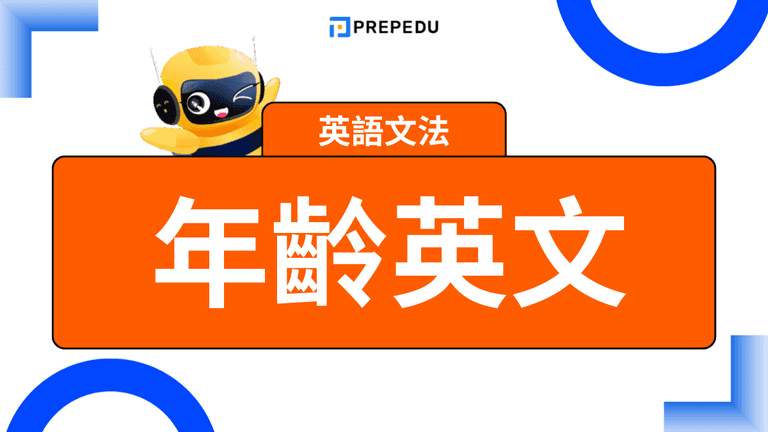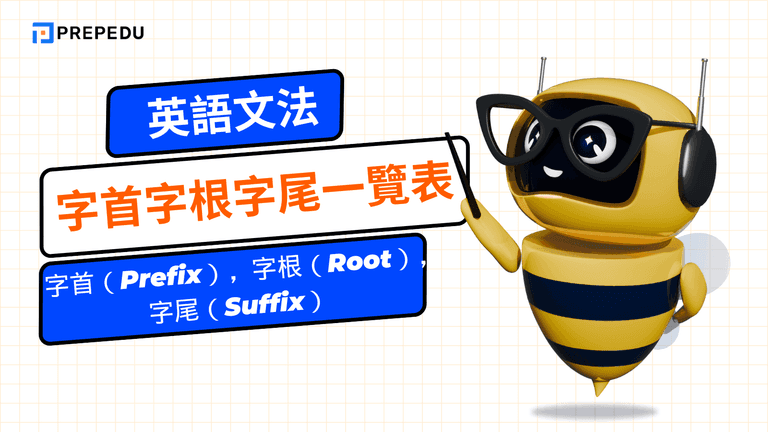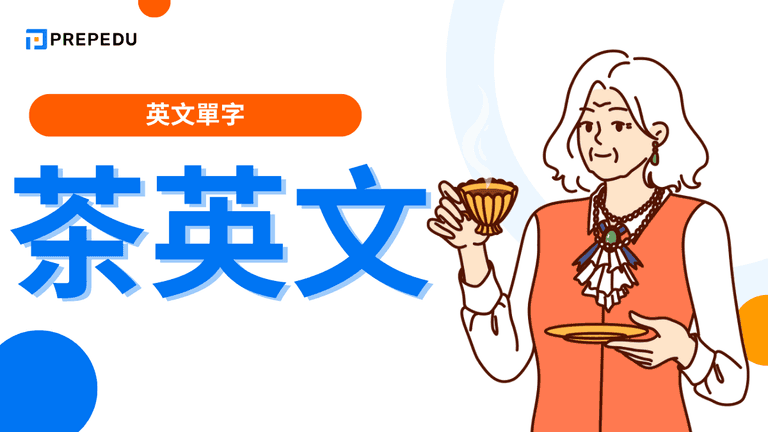英文關係代名詞(Relative Pronouns)Who/ Which/ That/ Whose/ Whom:完整用法,省略規則與題目大全
關係代名詞是什麼?如何正確使用 Who,Which,That? 關係代名詞是連接詞與代名詞的結合體,主要包含Who,Whom,Whose,Which,That 五種形式,用於引導形容詞子句修飾先行詞,讓句子表達更精簡專業。簡單來說,當您想要合併兩個句子,避免名詞重複時,關係代名詞就是最佳工具。例如「The student passed the exam. The student studied hard.」可以用Who 合併為「The student who studied hard passed the exam.」
然而,許多英文學習者在實際應用時常遇到困擾:Who 跟 Whom怎麼分?什麼時候一定要用That?關係代名詞可以省略嗎? 這些看似簡單的問題,背後卻牽涉到主格受格區別,限定非限定用法,以及複雜的省略規則。根據統計,關係代名詞相關錯誤是台灣學生在 IELTS 寫作和 TOEIC 文法測驗中最常見的失分點之一,特別是在逗號使用,That 的限制,以及關係副詞的混淆上。
PREPEDU 精心整理這篇全方位文法指南,從基礎定義,五大關係代名詞用法,限定與非限定差異,到進階的省略規則與複合關係代名詞,搭配50+實例與完整題庫,協助您徹底掌握這個英文文法核心概念,讓您的英文表達更加流暢自然。
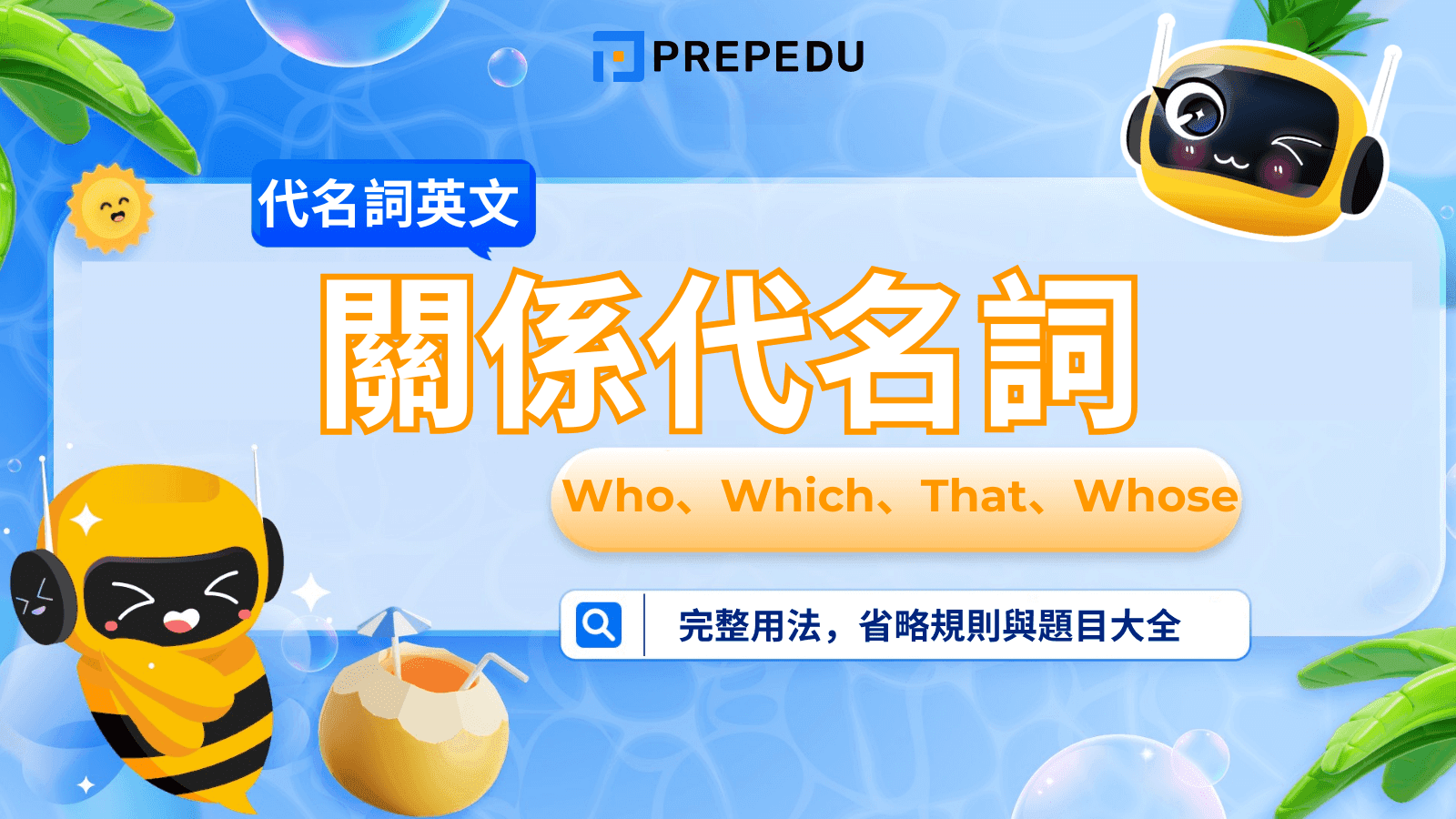
I. 英文關係代名詞(Relative Pronouns)定義與功能
關係代名詞是「連接詞英文」與「代名詞英文」的結合體,主要任務是引導形容詞子句來修飾前方的名詞(稱為「先行詞」)。關係代名詞有哪些?主要包含五種基本形式:Who,Whom,Whose,Which,That,它們讓我們能將兩個獨立句子合併成一個更流暢的表達方式,同時避免重複使用相同名詞。
舉關係代名詞例句來說,原本的兩句話「小王住在台北。小王是一位英文老師。」可以透過關係代名詞合併為 Xiaowang,who lives in Taipei,is an English teacher.(住在台北的小王是一位英文老師。)這種結構不僅讓句子更簡潔,也使表達更具專業性。
關係代名詞的核心功能:
-
連接作用:將先行詞與形容詞子句連結,扮演橋樑角色
-
代名作用:在形容詞子句中代替先行詞,擔任主詞,受詞或所有格
-
修飾作用:引導的形容詞子句用來補充說明或限定先行詞
-
簡化句子:避免名詞英文重複,使語句更流暢自然
基本公式:
先行詞 + 關係代名詞 + 形容詞子句(不完整句子)
理解關係代名詞文法的關鍵在於認識它的雙重身分,既是連接詞又是代名詞,這個特性使它在句中發揮獨特的語法功能。掌握這個核心概念後,接下來我們將深入探討各種關係代名詞的具體用法與選擇規則。
II. 英文關係代名詞種類與用法總表
關係代名詞有哪些?關係代名詞的選擇取決於兩個關鍵因素:先行詞的類型(人或物)以及關係代名詞在形容詞子句中的文法角色(主格,受格或所有格)。以下透過完整表格呈現各類關係代名詞的功能,適用情境與實例:
|
關係代名詞 |
先行詞類型 |
在子句中的角色 |
使用說明 |
可否省略 |
|
Who |
人 |
主格(主詞) |
後方直接接動詞,最常用於指涉人 |
不可省略 |
|
Whom |
人 |
受格(受詞) |
後方接「主詞+動詞」,正式寫作必須用,口語常用 Who 替代 |
可省略 |
|
Whose |
人/物 |
所有格 |
後方必須接名詞,表示所屬關係 |
不可省略 |
|
Which |
事物/動物 |
主格或受格 |
用於非人類先行詞,可用於限定或非限定子句 |
受格時可省略 |
|
That |
人/事物/動物 |
主格或受格 |
最萬用,但不可用於逗號後的非限定子句 |
受格時可省略 |
這張總表涵蓋了所有基本的關係代名詞用法,掌握這五種形式就能應對大部分句型轉換需求。接下來我們將逐一深入探討每種關係代名詞的細節與特殊用法。
1. 指涉「人」:Who 與 Whom 的區別
Who 關係代名詞 跟 Whom 怎麼分?這是學習者最常遇到的困惑。兩者最大差異在於它們在句中扮演的文法角色:Who 擔任主格功能,Whom 擔任受格功能。掌握這個區別的訣竅在於觀察關係代名詞後方的句子結構。
|
代名詞 |
結構 |
判斷方式 |
例句 |
|
Who 的用法與結構 |
先行詞(人)+ Who + 動詞... |
關係代名詞後方直接接動詞時,使用 Who |
|
|
Whom 的用法與結構 |
先行詞(人)+ Whom + 主詞 + 動詞... |
關係代名詞後方還有另一個主詞時,使用 Whom |
|
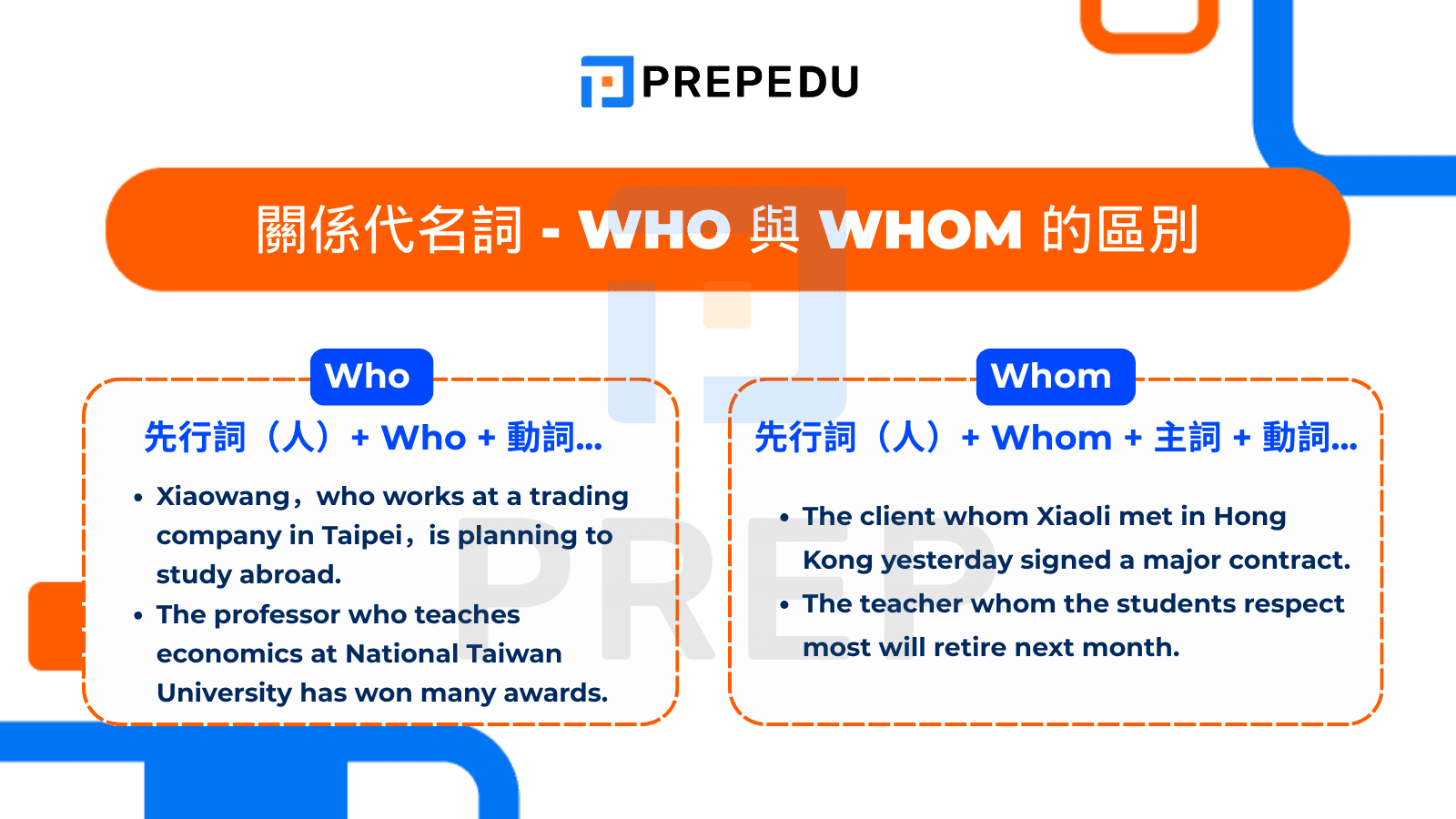
2. 指涉「事物/動物」:Which
結構與用法:
先行詞(事物/動物)+ Which + 動詞/主詞+動詞...
Which 專門用於指涉非人類的先行詞,包括物品,動物,概念或整個句子。在形容詞子句中,Which 可擔任主格或受格角色,使用上相當靈活。關係代名詞 Which 是描述事物特徵時最重要的工具之一。
|
代名詞 |
結構 |
例句 |
|
Which 當主格(主詞) |
先行詞(物)+ Which + 動詞... |
|
|
Which 當受格(受詞) |
先行詞(物)+ Which + 主詞 + 動詞... |
|
重要區別:在美式英語中,Which 關係代名詞主要用於非限定用法(逗號後),而限定用法(無逗號)時較常使用 That。但在英式英語中,Which 可以自由用於限定和非限定兩種情況。這個差異在學術寫作時需要特別注意。
3. 指涉「所有權」:Whose
什麼時候用 Who Whose?Whose 是唯一表示關係代名詞所有格,用來說明先行詞與某事物之間的所屬關係。與 Who 的區別在於,Who 表示「誰」(主格或受格),而 Whose 表示「誰的」(所有格),後方必須接名詞。
|
代名詞 |
結構 |
例句 |
|
Whose 指涉人的所有權 |
先行詞(人)+ Whose + 名詞 + 動詞... |
|
|
Whose 指涉物的所有權 |
先行詞(物)+ Whose + 名詞 + 動詞... |
|
替代用法:當 Whose 用於事物時,可以用「of which」結構替代,但 Whose 更為簡潔自然。例如:The house whose windows are broken 可以改寫為 The house the windows of which are broken,但前者明顯更簡潔流暢。記住:關係代名詞 Whose 後方一定要接名詞,這是它與其他關係代名詞最明顯的區別特徵。
4. 萬用代名詞:That
結構與特性:
先行詞(人/物/動物)+ That + 動詞/主詞+動詞...
關係代名詞 That 堪稱最萬用的選擇,它可以替代 Who,Whom 或 Which,用於指涉人或物。That 的優勢在於普遍適用性,無論先行詞是人還是事物,在大多數情況下都能使用 That 來引導形容詞子句。然而,That 也有重要的使用限制,必須謹慎遵守。
|
代名詞 |
結構 |
例句 |
|
That 指涉人 |
先行詞(人)+ That + 動詞/主詞+動詞... |
|
|
That 指涉事物 |
先行詞(物)+ That + 動詞/主詞+動詞... |
|
That 的重要限制:
-
禁止用於非限定子句(逗號後):當形容詞子句前有逗號分隔時,絕對不能使用 That,必須改用 Who 或 Which
-
禁止用於介系詞後方:當關係代名詞前有介系詞時,不能使用 That,例如「with which」不能說成「with that」
-
優先用於限定子句:That 最適合用在限定子句(無逗號),用來指定特定對象
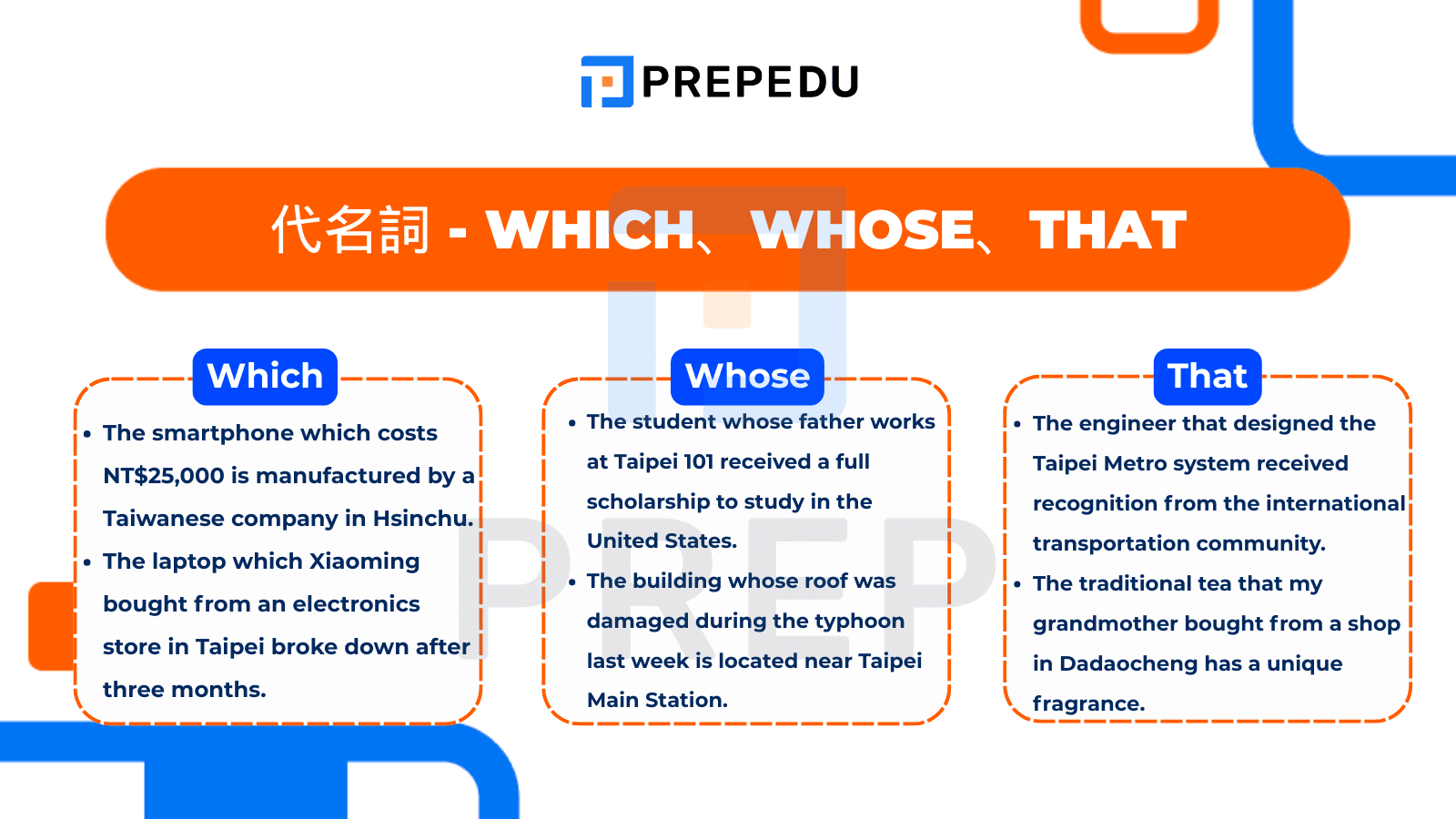
III. 限定與非限定用法(逗號的有無)
關係代名詞逗號的使用直接影響句意表達,這是關係代名詞限定非限定最關鍵的區別標記。限定子句與非限定子句在功能,意義和文法規則上都有明顯差異,理解這個概念對於精確表達至關重要。
限定子句 vs. 非限定子句比較表:
|
比較項目 |
限定子句 |
非限定子句 |
|
標點符號 |
無逗號分隔 |
前後用逗號分隔(,... ,) |
|
核心功能 |
指定特定對象,縮小範圍,篩選作用 |
補充額外資訊,不改變對象範圍 |
|
可否省略 |
不可省略,移除會改變句意或使句意不清 |
可省略,移除不影響主要句意 |
|
可用關係代名詞 |
Who,Whom,Which,That,Whose |
Who,Whom,Which,Whose(不可用 That) |
|
先行詞特性 |
通常是不特定或多數中的一部分 |
通常是特定,唯一或專有名詞 |
|
翻譯差異 |
通常譯為「...的」,強調限定範圍 |
通常譯為「...他/它」,強調補充說明 |
1. 限定子句詳解與實例
限定子句的核心功能是「篩選」,它從眾多可能的對象中指出特定的一個或一群。關係代名詞引導的限定子句是句子不可或缺的部分,移除後會導致句意改變或不清楚。
實例對比:
-
The students who passed the TOEIC exam will receive certificates at the ceremony in Taipei next month.(通過多益考試的學生下個月將在台北的典禮上獲得證書。)➡️ 限定用法:「who passed the TOEIC exam」篩選出通過考試的特定學生,不是所有學生
-
The restaurant that serves authentic Taiwanese cuisine near Longshan Temple is always fully booked.(龍山寺附近那家提供道地台灣料理的餐廳總是客滿。)➡️ 限定用法:「that serves authentic Taiwanese cuisine」指定是提供台灣料理的那家特定餐廳
2. 非限定子句詳解與實例
非限定子句扮演「補充說明」角色,提供的資訊雖然有用,但即使刪除也不會影響句子核心訊息。這種子句通常用於補充已經明確指定的對象(如專有名詞,unique object 或被清楚限定的名詞)的額外資訊。
實例對比:
-
My sister,who lives in Hong Kong,works as a financial analyst at an international bank.(我姊姊住在香港,她在一家國際銀行擔任財務分析師。)➡️ 非限定用法:「who lives in Hong Kong」補充說明姊姊的居住地,我只有一個姊姊,已經明確
-
Taipei 101,which was the world's tallest building until 2010,remains one of Taiwan's most iconic landmarks.(台北101在2010年之前是世界最高建築,至今仍是台灣最具代表性的地標之一。)➡️ 非限定用法:「which was the world's tallest building until 2010」補充歷史資訊,Taipei 101 已經唯一明確
判斷技巧:如果先行詞是專有名詞(人名,地名,公司名),被 my/our/this/that 等限定詞明確指定,或是唯一存在的對象,通常使用非限定子句。如果先行詞需要透過形容詞子句來界定是哪一個,則使用限定子句。
關鍵提醒:在非限定子句中,絕對不能使用關係代名詞 That。這是最容易犯錯的地方,必須改用 Who(指人)或 Which(指物)。
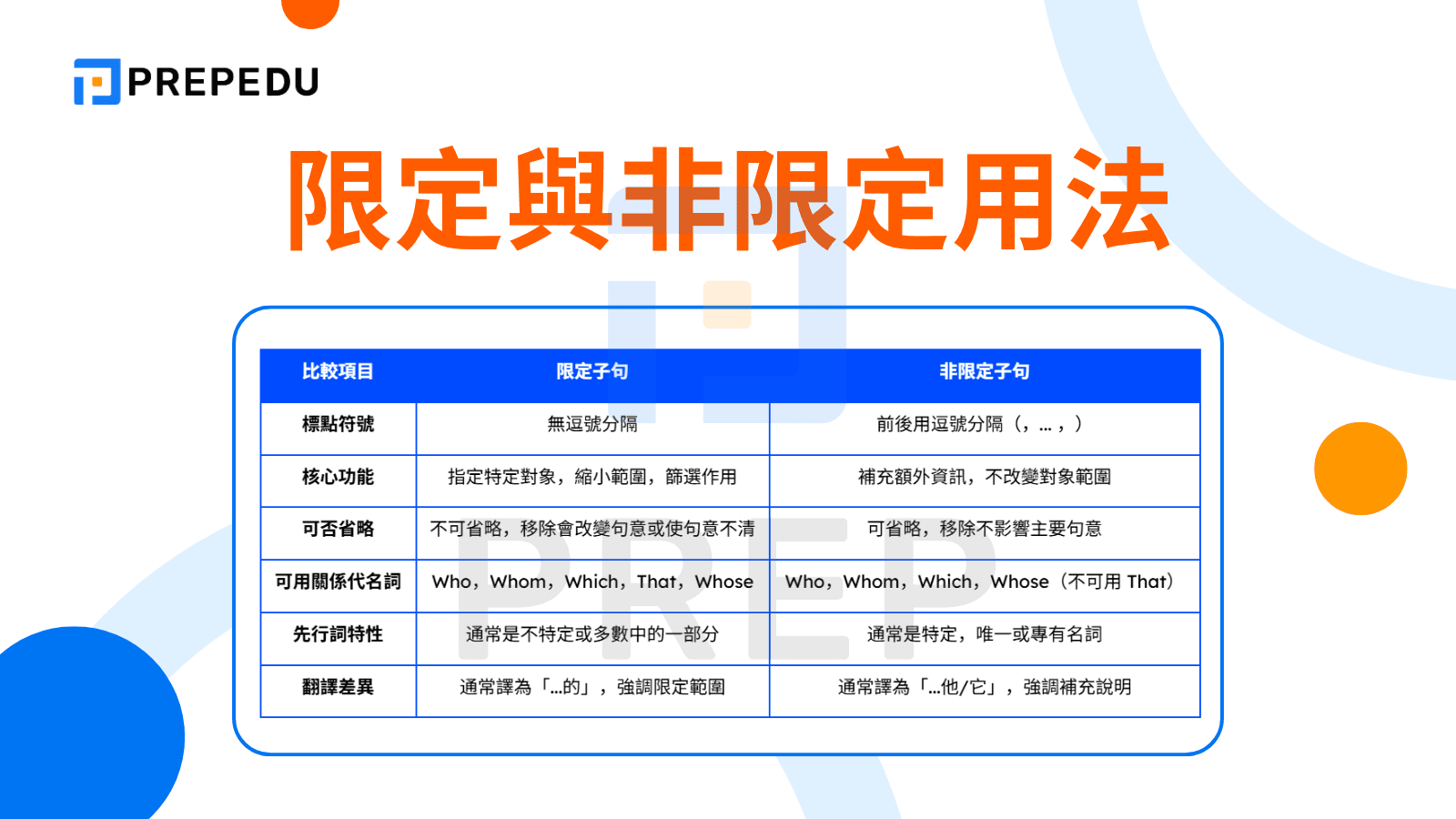
IV. 必用與禁用 That 的特殊規則
關代什麼時候一定要用 That?關係代名詞 That 雖然萬用,但在某些特定情境下有嚴格的使用規範。了解何時必須使用 That,何時強烈建議使用 That,以及何時絕對不能使用 That,是掌握進階關係代名詞用法的關鍵。
1. 必須或強烈建議使用 That 的情況
|
情況 |
結構 |
例句 |
說明 |
|
最高級修飾 |
The + 最高級 + 名詞 + that + 子句 |
This is the most challenging project that Xiaowang has ever worked on in Taipei.(這是小王在台北做過最具挑戰性的專案。) |
先行詞被最高級英文形容詞(best,most,worst 等)修飾時,必須用 that |
|
She is the smartest student that has ever attended this school in Hsinchu.(她是新竹這所學校歷來最聰明的學生。) |
最高級後方強制使用 that,不用 who |
||
|
序數詞修飾 |
The + 序數 + 名詞 + that + 子句 |
He was the first Taiwanese that climbed Mount Everest without supplemental oxygen.(他是第一位不使用氧氣瓶攀登聖母峰的台灣人。) |
先行詞被序數詞(first,second,last 等)修飾時,必須用 that |
|
This is the third time that Xiaoli has visited the Hong Kong Convention Centre this year.(這是小麗今年第三次造訪香港會議展覽中心。) |
序數詞後方使用 that,不用 which |
||
|
限定詞修飾 |
All/ Every/ Any/ The only + 名詞 + that + 子句 |
This is the only solution that can solve the technical problem in our Taipei headquarters.(這是唯一能解決我們台北總部技術問題的方案。) |
先行詞被 the only,the very,the same 修飾時,必須用 that |
|
All the participants that attended the conference in Hong Kong received a certificate.(所有參加香港會議的與會者都獲得了證書。) |
先行詞被 all,every,any,no,some 修飾時,用 that |
||
|
人+物並列 |
人 + and + 物 + that + 子句 |
They discussed the employees and policies that need to be changed in the Taichung branch.(他們討論了台中分公司需要改變的員工和政策。) |
先行詞同時包含人和物時,用 that 避免重複 who 和 which |
|
The teacher and the textbooks that helped me pass the IELTS exam were recommended by my friend in Tainan.(幫助我通過雅思考試的老師和教科書是我台南朋友推薦的。) |
人物並列時統一用 that,句子更簡潔 |
||
|
疑問詞開頭 |
Who/Which + be動詞 + 名詞 + that + 子句 |
Who is the person that called you from Kaohsiung this morning?(今天早上從高雄打電話給你的人是誰?) |
句子以疑問代名詞 Who/Which 開頭時,關代用 that 避免重複 |
|
Which is the company that offers the best salary package in the Hsinchu Science Park?(新竹科學園區哪家公司提供最好的薪資待遇?) |
避免 "Which is the company which..." 的重複用法 |
2. 絕對不能使用 That 的情況
|
情況 |
錯誤示範 |
正確用法 |
說明 |
|
逗號後(非限定子句) |
My brother,that works in Taipei,is getting married. ❌ |
My brother,who works in Taipei,is getting married. ✅(我在台北工作的哥哥要結婚了。) |
非限定子句(有逗號)絕對不能用 that,必須用 who/which |
|
Taipei 101,that is a famous landmark,attracts millions of visitors. ❌ |
Taipei 101,which is a famous landmark,attracts millions of visitors. ✅(台北101是著名地標,吸引數百萬遊客。) |
逗號後的補充說明不可使用 that |
|
|
介系詞後方 |
The pen with that I write is expensive. ❌ |
The pen with which I write is expensive. ✅(我用來寫字的那支筆很貴。) |
介系詞後方不能用 that,必須用 which/whom |
|
The colleague to that Xiaoming reported works in the Hong Kong office. ❌ |
The colleague to whom Xiaoming reported works in the Hong Kong office. ✅(小明向其報告的那位同事在香港辦公室工作。) |
"介系詞 + that" 是嚴重文法錯誤 |
記憶訣竅:關係代名詞 that 最適合用在「強調特定性」的限定子句中,特別是先行詞被最高級,序數詞,限定詞修飾時。相反地,當需要「補充說明」(有逗號)或「正式表達」(介系詞前置)時,就不能使用 that。
V. 關係代名詞的省略規則
關係代名詞省略是讓句子更簡潔流暢的重要技巧,但必須遵循特定文法條件才能正確省略。理解何時可以省略,何時不能省略,是提升英文寫作與口語表達自然度的關鍵。掌握關係代名詞的省略規則能讓您的英文更接近母語者的表達習慣。
1. 受格關係代名詞的省略規則
核心原則:當關係代名詞在形容詞子句中擔任受格(受詞)角色時可以省略
判斷方法:如果關係代名詞後方緊接著另一個主詞,那麼這個關係代名詞就是受格,可以省略
|
完整句子 |
省略關代後 |
文法說明 |
|
The smartphone(which/that)Xiaowang bought at the electronics store in Taipei stopped working after six months.(小王在台北電子商店買的那支智慧型手機六個月後就故障了。) |
The smartphone Xiaowang bought at the electronics store in Taipei stopped working after six months. |
which/that 後方有主詞 Xiaowang,所以是受格,可省略 |
|
The client(whom/that)our manager met in Hong Kong yesterday signed a three-year contract.(我們經理昨天在香港見到的那位客戶簽署了三年合約。) |
The client our manager met in Hong Kong yesterday signed a three-year contract. |
whom/that 後方有主詞 our manager,是受格,可省略 |
|
The restaurant(which/that)my colleague recommended in Tainan serves excellent beef noodles.(我同事推薦的台南那家餐廳提供很棒的牛肉麵。) |
The restaurant my colleague recommended in Tainan serves excellent beef noodles. |
which/that 是 recommended 的受詞,可省略 |
|
The teacher(whom/that)all students respect will retire at the end of this semester.(所有學生尊敬的那位老師將在本學期末退休。) |
The teacher all students respect will retire at the end of this semester. |
whom/that 後方有主詞 all students,可省略 |
重要限制:
-
非限定子句不可省略:逗號後的關係代名詞絕對不能省略,例如 My sister,who lives in Hong Kong,is a doctor. 中的 who 不能移除
-
介系詞前置時不可省略:當介系詞放在關係代名詞前方時不能省略,例如 The tool with which I work 中的 which 不能移除(但如果介系詞在句尾 The tool which I work with 則可省略 which)
2. 主格關係代名詞與 Be 動詞的同時省略
核心原則:當關係代名詞擔任主格且後方緊接著 Be 動詞時,可以同時省略「關係代名詞 + Be 動詞」,並將後方動詞改為分詞形式
轉換規則:
-
英文主動語態:關代 + is/are/was/were + V-ing → 省略後保留 V-ing(現在分詞)
主動語態的省略(V-ing)
|
完整句子 |
省略後(分詞構句) |
文法說明 |
|
The man who is standing at the entrance of Taipei Main Station is my former colleague.(站在台北車站入口的那個人是我以前的同事。) |
The man standing at the entrance of Taipei Main Station is my former colleague. |
同時省略 who is,保留現在分詞 standing |
|
The students who are studying in the library on the second floor are preparing for the TOEIC exam.(在二樓圖書館學習的學生正在準備多益考試。) |
The students studying in the library on the second floor are preparing for the TOEIC exam. |
省略 who are,動詞 studying 表示主動進行 |
|
The tourists who were visiting Hong Kong during the festival enjoyed the traditional celebrations.(節慶期間參觀香港的遊客欣賞了傳統慶祝活動。) |
The tourists visiting Hong Kong during the festival enjoyed the traditional celebrations. |
同時省略 who were,保留 visiting 表主動 |
|
Anyone who wants to join the hiking trip to Yangmingshan should register before Friday.(想參加陽明山健行之旅的人應在週五前報名。) |
Anyone wanting to join the hiking trip to Yangmingshan should register before Friday. |
省略 who,wants 改為 wanting(主動分詞) |
被動語態的省略(V-pp)
|
完整句子 |
省略後(分詞構句) |
文法說明 |
|
The products which are made in Taiwan are known for their high quality worldwide.(在台灣製造的產品以高品質聞名全球。) |
The products made in Taiwan are known for their high quality worldwide. |
同時省略 which are,保留過去分詞 made(被動) |
|
The report that was written by our team in the Taipei office received praise from headquarters.(我們台北辦公室團隊撰寫的報告獲得總部讚揚。) |
The report written by our team in the Taipei office received praise from headquarters. |
省略 that was,保留 written 表被動完成 |
|
The building which was built in 1920 in Tainan has been designated as a historical monument.(1920年在台南興建的這棟建築已被指定為歷史古蹟。) |
The building built in 1920 in Tainan has been designated as a historical monument. |
省略 which was,built 表被動(被建造) |
|
All applications that are received after the deadline will not be considered.(截止日期後收到的所有申請將不予考慮。) |
All applications received after the deadline will not be considered. |
省略 that are,received 為過去分詞(被接收) |
這種省略方式稱為分詞構句,在學術寫作,新聞報導和正式文件中特別常見,能讓句子更精簡有力。掌握這個技巧能顯著提升您的英文表達能力,讓寫作更具專業性。
注意事項:省略後的句子必須保持清晰,不能造成歧義。如果省略後意思不明確,建議保留完整的關係代名詞結構。
VI. 進階考點:先行詞是「句子」與複合關代
進階的關係代名詞用法包含兩個重要概念:整句當先行詞的特殊用法,以及複合關係代名詞的應用。這些是英文文法中較為複雜但實用性很高的結構,掌握這些進階技巧能讓您的英文表達更加精確專業。
1. 整句作為先行詞(,which 用法)
當我們想要用一個子句來評論或說明前面整個句子所描述的事件或情況時,可以使用「逗號 + which」的結構。這裡的 Which 不是指涉某個特定名詞,而是指前面整個句子的內容,在關係代名詞中是一個特殊且重要的用法。
結構:
完整句子 + ,which + 動詞...(評論或說明前面整件事)
重點提醒:
-
必須使用逗號分隔
-
只能用 Which,不能用 That
-
Which 代表前面整個句子的內容或情況
例句:
-
Xiaowang passed the IELTS exam with a score of 8.0,which made his family in Taipei extremely proud.(小王以8.0分通過雅思考試,這讓他在台北的家人非常驕傲。)➡️ which 指「通過考試這件事」,不是指 exam 或 score
-
The company decided to open a new branch in Kaohsiung,which surprised many investors.(公司決定在高雄開設新分公司,這讓許多投資者感到驚訝。)➡️ which 代表「公司決定開新分公司」整件事
2. 複合關係代名詞(Compound Relative Pronouns)
複合關係代名詞是將先行詞與關係代名詞合併在一起的特殊形式,它們本身就包含了先行詞的意義,因此後方不需要再出現名詞。這是關係代名詞的進階應用,在表達概括性陳述時特別有用。
主要複合關係代名詞
|
複合關係代名詞 |
相當於 |
意義 |
例句 |
|
Whoever |
Anyone who |
任何...的人 |
Whoever wants to attend the conference in Taipei can register online.(任何想參加台北會議的人都可以在線上註冊。) |
|
Whomever |
Anyone whom |
任何...的人(受格) |
The manager will hire whomever the HR department recommends for the position in Hong Kong.(經理將僱用人力資源部門推薦到香港職位的任何人。) |
|
Whatever |
Anything that |
任何...的事物 |
Whatever you decide to study at university will require dedication and hard work.(你決定在大學學習什麼都需要奉獻和努力。) |
|
Whichever |
Any one that |
任何一個 |
Whichever route you take from Taipei to Taichung,the journey will take about two hours.(你從台北到台中走哪條路線,行程都大約需要兩小時。) |
|
Wherever |
Any place where |
任何地方 |
Wherever Xiaoli travels in Taiwan,she always tries the local street food.(小麗在台灣旅行到任何地方,她總是嘗試當地小吃。) |
|
Whenever |
Any time when |
任何時候 |
Whenever I visit Hong Kong,I make sure to go to the Victoria Peak.(每當我造訪香港時,我一定會去太平山頂。) |
使用要點:
-
複合關係代名詞後方直接接子句,不需要先行詞
-
常用於表達普遍性,概括性的陳述
-
比使用「anyone who」或「anything that」更簡潔
3. 關係代名詞 What 的特殊用法
複合關係代名詞 What 或稱為關係代名詞 What 是一個特別重要的形式,它相當於「the thing(s)which」或「that which」,意思是「...的事物」或「...的東西」。What 的特殊之處在於它不能接在任何名詞後方,因為它本身就包含了先行詞。
結構:
What + 主詞 + 動詞 = The thing(s)which + 主詞 + 動詞
重要限制:What 不能用在名詞後方作為關係代名詞
|
正確用法 |
錯誤用法 |
說明 |
|
What he said at the meeting in Taipei made sense. ✅(他在台北會議上說的話很有道理。) |
The thing what he said made sense. ❌ |
what 已包含先行詞,不能再接在 thing 後 |
|
What Xiaoming needs is more practice in speaking English. ✅(小明需要的是更多英語口說練習。) |
The thing what Xiaoming needs is practice. ❌ |
what = the thing which,不能重複 |
|
What surprised me most was the efficiency of the Taipei Metro system. ✅(最讓我驚訝的是台北捷運系統的效率。) |
The matter what surprised me was... ❌ |
what 本身就是「讓我驚訝的事情」 |
|
I don't understand what you mean by that comment. ✅(我不明白你那個評論的意思。) |
I don't understand the idea what you mean. ❌ |
what you mean = the thing which you mean |
掌握複合關係代名詞與 What 的用法能讓您的英文表達更加道地自然,這些進階技巧在學術寫作和正式溝通中特別重要。
VII. 易混淆觀念釐清:關代 vs. 關副
關係代名詞與關係副詞經常被混淆,但兩者有明確的區別標準。最簡單的判斷方法是檢查形容詞子句的完整性:如果子句不完整(缺少主詞或受詞),就用關係代名詞;如果子句已經完整(有完整的主詞和受詞),就用關係副詞。這個觀念對於正確選擇關係詞至關重要。
關係代名詞 vs. 關係副詞比較表
|
比較項目 |
關係代名詞(Relative Pronouns) |
關係副詞(Relative Adverbs) |
|
種類 |
Who,Whom,Which,That,Whose |
Where,When,Why,How |
|
在子句中的角色 |
擔任主詞,受詞或所有格(名詞性角色) |
擔任副詞,修飾動詞(副詞性角色) |
|
子句完整性 |
子句不完整(缺主詞或受詞) |
子句完整(主詞和受詞都有) |
|
可否省略 |
受格時可省略,主格時不可省略 |
通常可省略 |
|
替換關係 |
無法用介系詞短語替換 |
可用「介系詞 + which」替換 |
|
先行詞類型 |
人,事物,動物 |
地點,時間,原因,方式 |
1. 關係代名詞詳細說明
特徵:關係代名詞在形容詞子句中擔任文法成分(主詞或受詞),移除後子句結構不完整
|
關係詞 |
例句 |
子句分析 |
|
Who(關代) |
The engineer who designed the Taipei 101 is world-famous.(設計台北101的那位工程師享譽全球。) |
子句:who designed the Taipei 101 ➡️ 移除 who 後:designed the Taipei 101(缺主詞)❌ |
|
Which(關代) |
The smartphone which I bought in Hong Kong has excellent features.(我在香港買的那支智慧型手機功能很棒。) |
子句:which I bought in Hong Kong ➡️ 移除 which 後:I bought in Hong Kong(缺受詞)❌ |
|
Whom(關代) |
The professor whom we met at the conference teaches at National Taiwan University.(我們在會議上遇到的那位教授在台灣大學教書。) |
子句:whom we met at the conference ➡️ 移除 whom 後:we met at the conference(缺受詞)❌ |
2. 關係副詞詳細說明
特徵:關係副詞在形容詞子句中擔任副詞,修飾動詞,子句本身結構完整(有主詞和受詞)
|
關係詞 |
例句 |
子句分析 |
可替換形式 |
|
Where(關副) |
This is the restaurant where I first met Xiaowang in Taipei.(這就是我在台北第一次遇見小王的那家餐廳。) |
子句:where I first met Xiaowang ➡️ 移除 where 後:I first met Xiaowang(完整)✅ ➡️ 只是缺地點副詞 |
at which,in which,on which |
|
When(關副) |
I still remember the day when I arrived in Hong Kong for the first time.(我仍然記得第一次抵達香港的那一天。) |
子句:when I arrived in Hong Kong ➡️ 移除 when 後:I arrived in Hong Kong(完整)✅ ➡️ 只是缺時間副詞 |
on which,at which |
|
Why(關副) |
That's the reason why Xiaoli decided to study abroad in the United Kingdom.(那就是小麗決定前往英國留學的原因。) |
子句:why Xiaoli decided to study abroad ➡️ 移除 why 後:Xiaoli decided to study abroad(完整)✅ ➡️ 只是缺原因副詞 |
for which |
|
How(關副) |
I don't understand the way how this machine works in the factory.(我不明白這台機器在工廠裡的運作方式。) |
子句:how this machine works ➡️ 移除 how 後:this machine works(完整)✅ ➡️ 只是缺方式副詞 |
in which<br>注意:the way 與 how 通常不連用 |
3. 特別注意:Where/When 不是關係代名詞
Where 關係代名詞和 When 關係代名詞這兩個說法其實是錯誤的,Where 和 When 是關係副詞,不是關係代名詞。這是學習者最常見的誤解之一。
實戰對比範例
|
先行詞 |
例句 |
類型 |
說明 |
|
place(地點) |
This is the place where I grew up in Tainan.(這是我在台南長大的地方。) |
關副 |
子句「I grew up」完整,用 where = in which |
|
place(地點) |
This is the place which I visited in Tainan.(這是我在台南參觀的地方。) |
關代 |
子句缺受詞(visited 的對象),用 which |
|
time(時間) |
I remember the time when we first met in Taipei.(我記得我們在台北初次見面的時候。) |
關副 |
子句「we first met」完整,用 when = at which |
|
time(時間) |
This is the first time that I have visited Hong Kong.(這是我第一次造訪香港。) |
關代 |
慣用法,time 後接 that,不用 when |
掌握關係代名詞與關係副詞的區別,能讓您在寫作和考試中避免常見錯誤,正確選擇適當的關係詞。
VIII. 實戰演練:關係代名詞題庫(附詳解)
以下提供三組關係代名詞題目,涵蓋基礎填空,句型合併與改錯,幫助您全面掌握這個重要的文法概念。每組練習都附有詳細解析,協助您理解答案背後的文法原理。
1. 練習一:基礎填空(選擇正確的關係代名詞)
請在下列句子中填入適當的關係代名詞練習(Who,Whom,Which,That,Whose):
-
The professor _____ teaches business management at National Taiwan University has published five books.
-
This is the laptop _____ Xiaowang bought from an electronics store in Guanghua Market last month.
-
The student _____ father works at TSMC in Hsinchu received a scholarship to study in the United States.
-
The building _____ roof was damaged during Typhoon Doksuri is located near Taipei 101.
-
The colleague _____ Xiaoli worked with on the project in Hong Kong was promoted to manager.
-
All the participants _____ attended the conference at the Taipei International Convention Center received certificates.
-
The traditional market _____ we visited in Tainan is famous for its seafood and local snacks.
-
He is the only engineer _____ can solve this complex technical problem in our company.
-
The documentary _____ won the Golden Horse Award is now showing in cinemas across Taiwan.
-
The neighbor _____ children attend the same school as my daughter often invites us for dinner.
點擊查看答案與詳解
-
who/that - 先行詞是人(professor),且在子句中當主詞(teaches 的主詞),可用 who 或 that。後方直接接動詞 teaches,所以是主格。
-
which/that(或可省略)- 先行詞是物(laptop),在子句中當受詞(bought 的受詞),可用 which 或 that。因為是受格(後方有主詞 Xiaowang),也可以省略關係代名詞。
-
whose - 表示所有格關係(學生的父親),後方接名詞 father。Whose 是唯一能表達所屬關係的關係代名詞,不可省略。
-
whose - 物的所有格(建築的屋頂),也可用「of which」但 whose 更簡潔。雖然先行詞是物,whose 仍然適用。
-
whom/who/that(或可省略)- 先行詞是人,在子句中當受詞(worked with 的對象),正式寫作用 whom,口語可用 who 或 that。因為是受格,也可省略。
-
who/that - 先行詞有 All 修飾,強烈建議用 that,但 who 也可接受。關係代名詞在子句中當主詞,不可省略。
-
which/that(或可省略)- 先行詞是物(market),當受詞使用(visited 的對象),可用 which 或 that。因為是受格(後方有主詞 we),可省略關係代名詞。
-
that - 先行詞有「the only」修飾,根據特殊規則必須用 that,不能用 who。這是必須使用 that 的典型情況。
-
which/that - 先行詞是物(documentary),當主詞使用(won 的主詞)。關係代名詞後方直接接動詞,所以是主格,不可省略。
-
whose - 所有格,表示鄰居的孩子們。Whose 後方必須接名詞(children),顯示所屬關係,不可省略。
2. 練習二:句型合併(將兩句合併成一句)
請使用適當的關係代名詞將下列兩句合併,並思考是否可以省略關係代名詞:
-
I have a colleague. She transferred to the Hong Kong office last month.
-
The coffee shop is very popular. It opened in Taipei's Xinyi District three months ago.
-
The manager is very strict. We report to him every week.
-
She showed me the photos. She took the photos during her trip to Taroko Gorge.
-
The hotel is near Sun Moon Lake. We stayed at the hotel during the Chinese New Year holiday.
-
Mr. Chen is my neighbor. His son won first prize in the national science competition.
-
The article was very informative. I read it in the Common Wealth Magazine this morning.
-
Students should practice speaking English regularly. They want to improve their fluency.
-
The restaurant serves authentic Taiwanese cuisine. It was recommended by my friend from Taichung.
-
The smartphone has many advanced features. Xiaoming bought it at a store in Ximending.
點擊查看答案與詳解
-
I have a colleague who/that transferred to the Hong Kong office last month.(我有一位上個月調到香港辦公室的同事。)➡️ 限定子句,who/that 當主詞(後方直接接動詞 transferred),不可省略。
-
The coffee shop which/that opened in Taipei's Xinyi District three months ago is very popular.(三個月前在台北信義區開幕的那家咖啡店非常受歡迎。)➡️關代當主詞(後方直接接動詞 opened),不可省略。可用 which 或 that。
-
The manager to whom we report every week is very strict. 或 The manager whom/that we report to every week is very strict. 或 The manager we report to every week is very strict.(我們每週向他報告的那位經理非常嚴格。)(省略關代)➡️ 正式寫法:介系詞 to 前置,用 to whom。非正式寫法:介系詞 to 放句尾,可用 whom/that 或省略。
-
She showed me the photos(which/that)she took during her trip to Taroko Gorge.(她給我看她太魯閣之旅期間拍攝的照片。)➡️ 關代當受詞(took 的對象),可省略。先行詞是物,用 which 或 that。
-
The hotel(which/that)we stayed at during the Chinese New Year holiday is near Sun Moon Lake. 或 The hotel at which we stayed during the Chinese New Year holiday is near Sun Moon Lake.(我們農曆新年假期入住的那家飯店靠近日月潭。)➡️ 介系詞 at 可放句尾(關代可省略)或前置於關代前(不可省略)。
-
Mr. Chen,whose son won first prize in the national science competition,is my neighbor.(陳先生是我的鄰居,他的兒子在全國科學競賽中獲得第一名。)➡️ 專有名詞,用非限定子句(逗號),使用所有格 whose。不可用 that。
-
The article(which/that)I read in the Common Wealth Magazine this morning was very informative.(我今天早上在《天下雜誌》讀到的那篇文章資訊很豐富。)➡️ 關代當受詞(read 的對象),可省略。先行詞是物,用 which 或 that。
-
Students who/that want to improve their fluency should practice speaking English regularly.(想提升流利度的學生應該定期練習說英語。)➡️ 限定子句,關代當主詞,不可省略。指特定想提升流利度的學生。
-
The restaurant which/that was recommended by my friend from Taichung serves authentic Taiwanese cuisine. 或 The restaurant which/that serves authentic Taiwanese cuisine was recommended by my friend from Taichung.(我台中朋友推薦的那家餐廳提供道地台灣料理。)➡️ 兩種合併方式都正確,關代當主詞時不可省略。
-
The smartphone(which/that)Xiaoming bought at a store in Ximending has many advanced features.(小明在西門町一家店買的那支智慧型手機有許多先進功能。)➡️ 關代當受詞(bought 的對象),可省略。先行詞是物,用 which 或 that。
3. 練習三:改錯與選擇(找出錯誤或選擇正確答案)
請判斷下列句子是否正確,若有錯誤請改正並說明原因:
-
The book,that I bought at Eslite Bookstore in Taipei,is very interesting.( )
-
This is the night market where I first tried stinky tofu.( )
-
All what you need is confidence and practice.( )
-
The girl who she works at the bank in Hong Kong is my cousin.( )
-
My brother,that lives in Taichung,is a software engineer.( )
-
He is the most talented musician that I have ever met in Taiwan.( )
-
The teacher whom teaches mathematics is very patient.( )
-
This is the first time which I visit Alishan National Scenic Area.( )
-
The laptop with that I work was purchased in the United States.( )
-
Students study hard at National Taiwan University usually get good grades.( )
點擊查看答案與詳解
-
錯誤 ❌
-
改正:The book,which I bought at Eslite Bookstore in Taipei,is very interesting.(我在台北誠品書店買的那本書非常有趣。)
-
原因:逗號後的非限定子句不能用 that,必須用 which。這是關係代名詞 that 的重要限制之一。
-
-
正確 ✅
-
說明:Where 是關係副詞,不是關係代名詞。子句 I first tried stinky tofu 結構完整(有主詞和受詞),只是缺地點副詞,所以用 where 正確。Where = at which(在那個夜市)。
-
中文翻譯:這就是我第一次嘗試臭豆腐的那個夜市。
-
-
錯誤 ❌
-
改正:All(that)you need is confidence and practice. 或 What you need is confidence and practice.(你所需要的就是信心和練習。)
-
原因:What 本身包含先行詞,不能與 All 連用。應該用「All that」或直接用「What」(= the thing that)。
-
-
錯誤 ❌
-
改正:The girl who works at the bank in Hong Kong is my cousin.(在香港銀行工作的那個女孩是我表妹。)
-
原因:主詞重複。Who 已經代表「the girl」,不能再出現代名詞 she。關係代名詞本身就在子句中擔任主詞。
-
-
錯誤 ❌
-
改正:My brother,who lives in Taichung,is a software engineer.(我哥哥住在台中,他是軟體工程師。)
-
原因:逗號後的非限定子句不能用 that,必須用 who(指人)。專有名詞或已明確指定的對象後方通常用非限定子句補充說明。
-
-
正確 ✅
-
說明:先行詞被最高級「the most talented」修飾,根據特殊規則應該用 that。這是必須使用 that 的典型情況。
-
中文翻譯:他是我在台灣遇過最有才華的音樂家。
-
-
錯誤 ❌
-
改正:The teacher who teaches mathematics is very patient.(教數學的那位老師非常有耐心。)
-
原因:Whom 是受格,但這裡需要主格。關係代名詞後方直接接動詞 teaches,顯示它在子句中當主詞,應該用 who 而非 whom。
-
-
錯誤 ❌
-
改正:This is the first time that I visit Alishan National Scenic Area. 或 This is the first time I visit Alishan National Scenic Area.(這是我第一次造訪阿里山國家風景區。)(省略 that)
-
原因:Time 後通常用 that 或 when,但在「This is the first/second/last time」句型中,慣用 that 或省略。不用 which。
-
-
錯誤 ❌
-
改正:The laptop with which I work was purchased in the United States.(我用來工作的那台筆記型電腦是在美國購買的。)
-
原因:介系詞後方不能用 that,必須用 which(指物)或 whom(指人)。「介系詞 + that」是嚴重的文法錯誤。
-
-
錯誤 ❌
-
改正:Students who/that study hard at National Taiwan University usually get good grades.(在台灣大學努力學習的學生通常會獲得好成績。)
-
原因:缺少關係代名詞連接。需要用 who 或 that 來連接先行詞「Students」和形容詞子句「study hard」。
-
結論
關係代名詞不僅是考試的重點,更是日常英文溝通,學術寫作和專業表達的必備工具。持續練習應用,您的英文表達將更加流暢自然。無論您是準備 IELTS,TOEIC 等語言檢定,或是希望提升整體英文能力,掌握關係代名詞都將是您邁向成功的重要基石。
面對緊迫的考試期限和龐大的準備內容感到壓力?PREP 理解這種處境,致力於在有限時間內最大化你的學習成果。
放棄漫無目的的練習。系統運用測驗結果精準分析你的優勢和弱點,找出你急需改善的核心能力。這種智能學習策略比傳統方法節省高達 50% 的時間。
雅思模擬試題和 TOEIC 線上題庫依難度排列,幫助你先鞏固基礎再逐步建立技能。你投入的每分鐘都創造價值,每次測驗都推動你朝目標前進。
別讓時間流逝而沒有真正成果。今天就開始 PREP 的智能學習之旅,找到達成理想分數的最短路徑!

你好!我叫黃秋賢。現在在網站 prepedu.com 的部落格擔任產品內容經理。
我有超過5年的英語、韓語等外語自學經驗,並準備過 IELTS、TOEIC、TOPIK 等考試,累積了豐富的實戰知識,也曾協助數千位在語言學習上遇到困難的人。希望以上的分享能幫助大家在家中更有效率地自學!
評論


